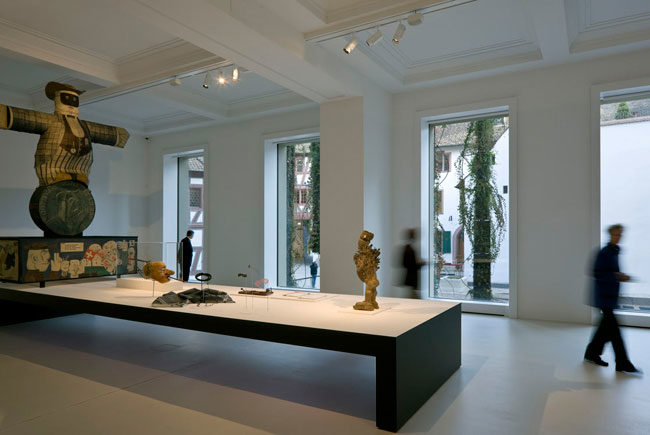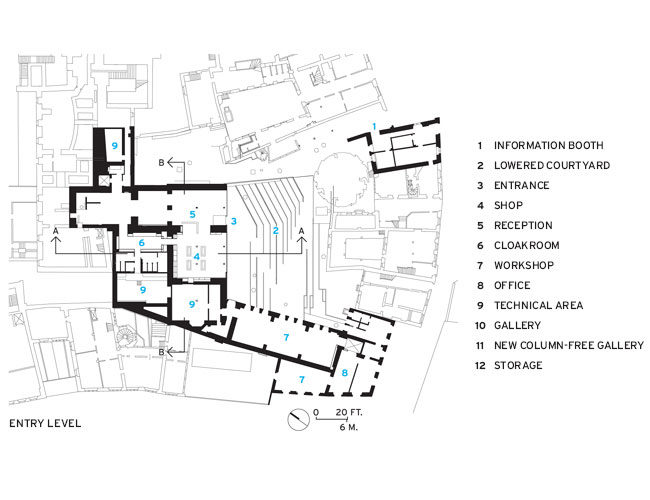Basel, Switzerland
An architectural tour of Basel and its environs reveals no fewer than 21 completed buildings by the office of natives Jacques Herzog and Pierre de Meuron, with a major addition to the city's convention center and a 213-foot office tower for Novartis slated for 2013 and 2015 completion, respectively.
This verdant corner of Switzerland, known for its patronage of contemporary art and architecture, has been fertile ground for the architects, allowing them the freedom to hone their exhaustive palette of bold strategies and materials through a range of projects, including the twisted, copper-clad Central Signal Box (1999), built for the Swiss Federal Railway, and the whimsically stacked VitraHaus (2009) in nearby Weil am Rhein, Germany. However, when the firm was tapped to upgrade the Museum der Kulturen (Museum of Cultures) in Basel's medieval historic center, preservation issues nearly compromised its typical design autonomy. A thoughtful tribute to the city the partners grew up in, their surprising solution resonates with a confidence and restraint that pays homage to the past with a clear vision toward the future.
Home to one of the most important ethnographic collections in Europe, the Museum of Cultures dates back to 1849, when it opened in the institution's existing Neoclassical building designed by local architect Melchior Berri, which replaced an Augustinian monastery. Its location, backing onto a private courtyard, accommodated a 1917 annex by Vischer & S'hne, but there was little room for growth when the Museum Foundation and Basel Building and Planning Department called upon Herzog & de Meuron to create a new entrance and large multiuse gallery in 2001. The museum's collection had grown to over 300,000 cultural artifacts and photographs from diverse geographic regions, so an expansion was essential. The administration also wanted to make the building more inviting to the public and academic community with improved facilities.
To retain the existing footprint, the design team devised a playfully gabled volume above the annex for the expansion, creating a higher, larger roof'a scheme that raised red flags among preservationists. According to senior partner in charge Christine Binswanger, 'Private heritage associations opposed it because the project would change the roofscape of the old town.' But, after a protracted judicial battle, the plan was approved. 'It just needed patience,' she explains. 'Our clients were convinced that the public's interest in the museum expansion would overrule the resistance.'
The opposition was unwarranted. The ensuing intervention fits comfortably in the quaint urbanscape dominated by traditional timber-frame buildings and the tapered spires of Basel's red sandstone cathedral (or M'nster). As a fond gesture, the jagged gables of the controversial roof are clad in iridescent-green ceramic tiles, to echo vivid mosaics atop the church.
Perched on the 20th-century annex as if dropped from the sky, the lofty addition is a lightweight-steel, space-frame structure that cantilevers on three sides of the building, providing a 6,500-square-foot column-free gallery within it. This complex construction required substantial support, so the crew reinforced two outer walls with three steel pillars that take the loads directly to the foundations. They also installed a layer of composite steel over the existing ceiling of the former top floor to bear the weight of the new gallery floor.
Previously, the Museum of Cultures shared an entrance with the city's Natural History Museum. To bolster their client's identity, Herzog and de Meuron relocated the entrance to the basement level at the rear of the building, opening the cloistered courtyard to the town's main square, the M'nsterplatz'a highly visible location. Now visitors access the museum through an arched passageway, where the architects created a gently stepped and ramped path that leads them to the glazed lobby and gift shop. A curtain of spiraling plants from the underside of the addition introduces an element of life and natural color that animates the architecture.
Inside, the firm tackled the scope of work, which included the installation of elevators, with such subtlety it seems virtually untouched. For the most part, 'we cleaned up and organized the technical features of the existing exhibition spaces,' says Binswanger. She and her colleagues also restored the original structure of the old rooms, crafted a double-height gallery from two, and whitewashed the walls, contrasting them with graphic, matte-black elevator alcoves. Their most assertive move was to eliminate windows for wall space and to enhance the building's weight and elegance.
'It had too many windows,' recalls Binswanger. 'There was too much daylight for the exhibitions, and it looked like a school. So we closed the facade and punctuated it with fewer openings.' Enlarged to reach the floor, the remaining windows have deep reveals that frame views of medieval Basel, a metaphorical and physical connection that'like Herzog & de Meuron's thoughtful renovation'links the museum to the evolving city around it.
Completion Date: September 2011
Gross square footage: 24,811 square feet (including courtyard)
Client: Construction lot 1:Stiftung Museum der Kulturen, Basel, Switzerland
Construction lot 2 and 3: Kanton Basel-Stadt
People
Client
Architect:
Personnel in architect's firm who should receive special credit:
Project Team 2001-2004
Planning Architect Construction: Proplaning AG Architekten, Basel, Switzerland Structural Engineering: ZPF Ingenieure, Basel, Switzerland Construction Management: Proplaning AG Architekten, Basel, Switzerland HVAC Engineering: Waldhauser Haustechnik AG, Basel, Switzerland Plumbing Engineering: Aqua Planing, Arlesheim, Switzerland Electrical Engineering: Herzog Kull Group AG, Basel, Switzerland Landscape Design: Rapp Infra AG, Basel, Switzerland
Photographer(s) |
Products
Contractors
Manufacturers |







































































